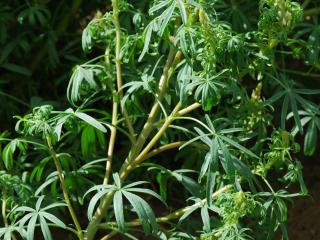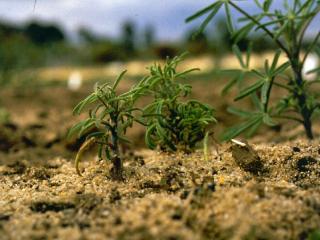Symptoms
CMV infection causes lupin leaves to become pale, bunched and down curled with faint mosaic. In plants that grow from infected seed, all leaves develop these symptoms and these plants are severely stunted. Healthy plants that become infected during the growing season have pale, bunched young leaves with faint mosaic while older leaves formed prior to infection appear normal. As growth continues, all new leaves show symptoms and the infected plants become stunted. The earlier a plant becomes infected, the fewer the pods set, the smaller the size of seed produced and the smaller the yield. With late infections symptoms are restricted to tip leaves.


Sources of virus
Sowing infected seed produces infected seedlings scattered at random within the crop. Aphids pick up the virus from the infected plants and spread it to nearby healthy plants. When infection incidence reaches 100%, the maximum possible seed transmission rate to seedlings varies with lupin variety.
In the wheatbelt, although infected lupin seed is the only CMV source of consequence for lupin crops, other legume hosts can become infected, including clovers, chickpea, faba bean, lentil and field pea. Weeds that sometimes become infected include capeweed, stagger weed and fumitory, but the virus is not seed-borne in these species so infection is lost over summer.
Aphid vectors
CMV is spread by many aphid species, including green peach (Myzus persicae), blue green (Acyrthosiphon kondoi) and cowpea (Aphis craccivora) aphids that colonise lupins as well as migrants of common non-lupin colonising species, especially oat (Rhopalosiphum padi) and turnip (Lipaphis erysime) aphids. CMV is transmitted non-persistently: an aphid picks it up within one to two seconds while probing an infected plant, but the virus is then lost again when the aphid probes one or two healthy plants.
Yield losses
Yield losses can reach 60% when all plants in a crop become infected. Losses from CMV infection are greatest when seed with >1% infection is sown, aphids arrive early and widespread plant infection occurs.
The outcome of sowing seed infected with different levels of CMV varies greatly from year to year and site to site. Sowing seed with a high level of infection, which develops many in-crop sources, together with an early arrival of aphids initiates substantial early epidemics resulting in high disease incidence, reduced yield and increased infection in harvested seed. By contrast, with a dry start to the growing season, sowing seed with a high level of infection results in minimal yield loss and reduction in infection levels in harvested seed. The aphids arrive much later, resulting in a much reduced CMV spread.
| Scenario | 1 | 2 | 3 | 4 |
|---|---|---|---|---|
| Initial CMV seed infection level | 5% | 0.5% | 5% | 0.5% |
| Aphid arrival | Early | Early | Very late | Very late |
| Final crop infection | 89-95% | 34-53% | 1-2% | 0.1% |
| Yield loss | 36-53% | ns | ns | ns |
| Harvested CMV seed infection level | 12-13% | 7% | 0.6% | 0.1-0.2% |
ns=yield impact is not statistically significant
Influence of weather
The date of first arrival of aphids flying from pastures into crops is directly related to the magnitude of rainfall events in late summer and early autumn. Rainfall stimulates plant growth before the growing season, providing hosts (clovers, weeds and volunteer crop plants) that encourage rapid aphid multiplication. When lupin crops emerge, aphid flights invade them early and spread CMV from seed-borne infected seedlings to healthy ones which initiates early spread of CMV. When there is little or no summer or autumn rain, few plants are available to support aphids before crops are sown. Aphids take much longer to build up and arrive much later so CMV spread starts much later. In low risk areas, this scenario occurs more frequently than in high risk areas.
Management
An integrated disease management approach is needed to control CMV in lupin crops, one which uses a range of control measures.
- Sowing healthy lupin seed. This is the most important measure. A representative seed sample is tested to determine the level of infection. In low risk areas, seed with <0.5% infection can be sown without undue risk of yield loss. Seed infection of <0.1% (a zero result from a 1000 seed test) is recommended for grain crops in high risk areas, and for seed certification crops in any rainfall zone. Seed testing can be done through AgWest Plant Laboratories, South Perth.
- Sow early at high seeding rates using narrow row spacing to promote early crop canopy coverage. This deters aphids from landing and shades over the seed-infected and early infected plants, denying aphids access to them.
- Direct drill into retained stubble. Ground cover reduces aphid landing rates before a crop canopy develops, especially with wide row spacing.
- Isolate from neighbouring lupin crops.
- Maximise weed control. This reduces spread of CMV from lupins to weeds and then from weeds back to lupins.
Note: Insecticides applied to crops are ineffective at controlling CMV.

